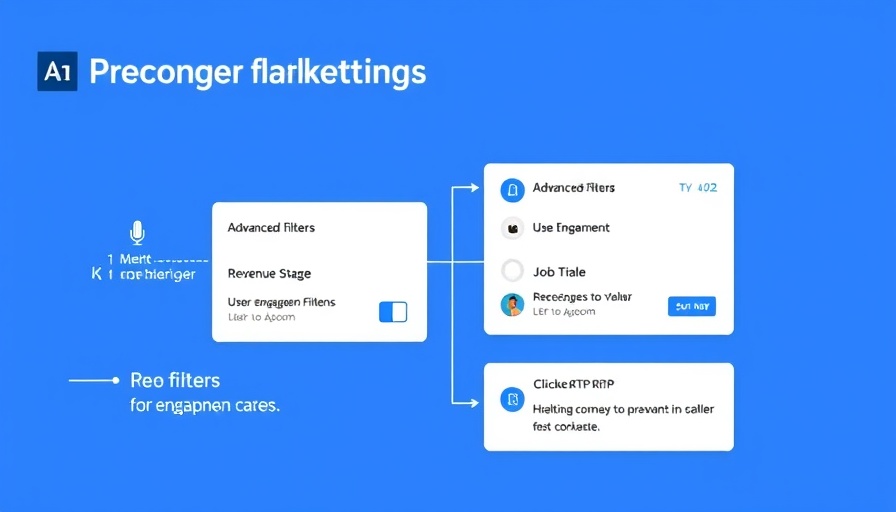
Unlocking the Power of Account-Based Marketing for B2B Success
For business owners and marketers, understanding how to connect effectively with decision-makers has become increasingly critical. Conventional lead generation strategies might feel like throwing darts blindfolded; the targets are not only scattered but often non-responsive. This is where Account-Based Marketing (ABM) innovates by flipping the conventional approach upside down. Rather than waiting for potential leads to come to you, ABM narrows the focus to a select group of high-value accounts, tailoring marketing efforts to directly resonate with their needs. This proactive engagement is not merely efficient; it's transformative.
What is Account-Based Marketing (ABM), and Why Does it Matter?
At its core, ABM is a strategy that coordinates both marketing and sales teams to engage, nurture, and convert key accounts. This amalgamated approach recognizes a critical principle: not all leads are created equal. This is especially significant in enterprise sales, where multiple stakeholders play a role in purchasing decisions; thus, marketing efforts need to reflect a keen understanding of each account's unique context. By centering on quality rather than quantity, ABM fosters robust customer relationships, enhances conversion rates, and ultimately boosts customer lifetime value.
Adobe Marketo Engage: The Ideal Tool for Your ABM Strategy
Adobe's Marketo Engage stands as a beacon for businesses looking to amplify their ABM initiatives. Designed for sophisticated marketing automation, it facilitates a seamless workflow for both marketing and sales teams, fostering collaboration like never before. With this platform, teams can align their strategies on a unified basis, personalizing engagement while measuring their impacts through real-time analytics.
Key Features of Marketo Engage that Empower ABM
- AI-Powered Personalization: Marketo Engage utilizes artificial intelligence to tailor dynamic content to meet distinct buyer personas, ensuring a personalized experience every step of the way.
- Comprehensive Campaign Management: Craft intricate ABM workflows easily using intuitive drag-and-drop functionalities. This feature allows businesses to create cohesive multi-step journeys across diverse platforms.
- CRM Integration: Leverage seamless connectivity with popular CRM systems like Salesforce, ensuring data continuity between marketing and sales teams, which is crucial for effective communication.
- Robust Marketing Analytics: Gain insights into account engagement and campaign impact with multi-touch attribution tools, allowing for an accurate assessment of Return on Investment (ROI).
- Omnichannel Engagement: Execute cross-channel campaigns effectively by synchronizing efforts across emails, web content, advertisements, and more, creating a harmonious engagement strategy.
Future Trends in Account-Based Marketing
As the landscape of marketing continues to evolve, ABM stands out as an area poised for significant growth. With data analytics and AI technologies driving personalization further, businesses will rely heavily on sophisticated tools like Marketo Engage to optimize their engagement efforts. Additionally, as remote and hybrid work becomes the norm, understanding digital touchpoints will also become crucial. Businesses that tap into these future trends can position themselves advantageously to strengthen connections and drive growth in their sectors.
Common Misconceptions about ABM
Despite its advantages, ABM is often misunderstood. One prevalent myth is that ABM requires extensive resources that only larger enterprises can afford. In reality, ABM can be tailored to fit businesses of all sizes. Additionally, some believe that ABM equates to mass marketing personalized minimally. However, effective ABM hinges on a hyper-personalized approach that creates unique experiences for each targeted account.
Actionable Insights for Implementing ABM
To effectively implement an ABM strategy within your own organization, commence by identifying your ideal customer profile. Collaborate with both marketing and sales teams to unify on the specifications of your target accounts. Next, leverage tools like Marketo Engage to streamline your campaigns, ensuring all interactions are targeted and relevant. Lastly, continuously analyze and refine your strategies based on performance data to optimize engagement.
Why This Matters for Business Owners
For business owners seeking growth strategies, the adoption of ABM can close the gap between traditional lead generation and modern marketing efforts. By focusing on targeted accounts rather than mass outreach, business owners can cultivate deep relationships with their clients. This not only enhances conversion rates but ultimately secures a sustainable path to revenue growth.
In conclusion, embracing Account-Based Marketing and utilizing tools like Adobe Marketo Engage equips businesses with the capability to streamline their strategies effectively and engage their most significant accounts compellingly. By understanding and implementing personalized marketing experiences, business owners can drive results and build lasting connections within their markets.
 Add Row
Add Row  Add
Add 




Write A Comment